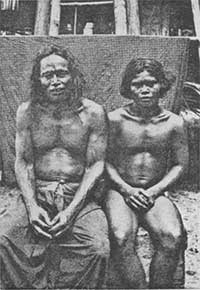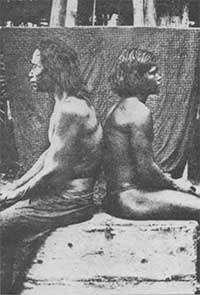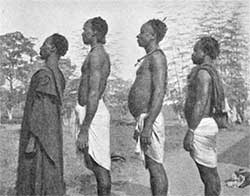
Photographic Anthropological Portraits
in British Scientific Journals, 1860-1930
- Valérie Morisson
_______________________________

Fig. 1. Coast Natives of Great Nicobar,
JAIGBI, 1889 

Fig. 2.Coast Natives of Great Nicobar,
JAIGBI, 1889 

Non-photographic type portraits predate photographic ones. They are characterized by a focus on the bust or the face as well as by multiple views of the same person from different angles. Serving Darwinian anthropology, engraving facilitated the enhancement of common facial characteristics to abstract common physiognomic traits and racial types. In an 1868 article from the Review [21], a series of human and animal heads is drawn to illustrate the author’s argument that “in her production of organic forms Nature has obviously advanced from lower to higher, from the simpler to the more complex, from the coarser and ruder to the finer and the more complex, from the less to the more specialized.” The Turan type (Persian) is identified as the lowest type of man remaining north of the tropic. The juxtaposition of small-scale faces supports a hierarchical understanding of races. Scientific ethnological drawings documenting body ornaments followed the same compositional conventions while providing stereotypical and homogenized images of ethnic groups. Drawings were nonetheless valued as scientific evidence. In his article “On the Kubus of Sumatra,” H. O. Forbes, who had examined some of the people and obtained a cranium as well as a skeleton, included four outline drawings representing a woman’s features “very truthfully.” [22] Conversely, in 1857, George Gliddon bemoaned the lack of accurate representations of the branches of mankind and noted that while engravings recorded details of dress, artists habitually Europeanized the physical features of native people [23].
Anthropometric photography was influenced by these scientific drawings insofar as they were understood as true-to-life and scientific by the viewers [24]. “Photographic representation was firmly based in established pre-photographic ways of seeing” [25] so that “photography should be viewed as a continuation of this illustrative tradition both in functional and representational terms.” [26] However, on account of its realistic appearance, photography could back up scientific discourses more convincingly. In the 1850s, Louis Agassiz commissioned a series of daguerreotypes documenting the anatomy of black slaves and backing up his polygenist theories [27]. Though these frontal studio portraits of bare-breasted figures are shot against plain backgrounds, the expressive gazes of the sitters and their poses evoke non-scientific portraits.
Departing from artistic aesthetics, new photographic methods were developed to “record, document, and describe within the boundaries of certain perceived standards of logical rigour and observational skill.” [28] Anthropometric photographic portraits were conceived according to standardized compositions to facilitate the observation and measurement of specimens of races. As many of the practitioners in anthropology had a scientific background in the natural sciences or medicine, the parameters of visual representation that they defined were conditioned by their initial ideas of visual truth [29]. In 1869, John Lamprey, who conceived his system for both scientists and artists, required two full-length images: frontal and in profile. He advocated that all subjects should be photographed naked, in stiff anthropometric poses, and recommended the use of a metrological grid as a background [30]. The very same year, Henry Huxley, who considered Lamprey’s method as flawed, made further recommendations [31], notably on the poses and the distance between the sitters and the camera. To prevent emotions from interfering, the subject should not look at the photographer. In both systems, the European figure served as a reference while the grid culturally shaped the image [32]. Minute recommendations were transmitted to colonial governors heading photographic surveys throughout the British Empire to ensure that shots could serve the comparative projects. The systematic photographic record of the populations of the British Empire, undertaken by The British Association for the Advancement of Science in 1878, fulfilled an illustrative and authoritating function [33]. In anthropometric portraits, otherness was ideologically staged [34]; the bodies were strictly adjusted and controlled [35]; the colonial races “under photographic surveillance” “were ‘forced to yield to the minutest scrutiny of gestures and features.” [36] Nakedness, which was a prerequisite, gave a false image of the natives, very few of whom would actually go naked in their natural environments.
Notwithstanding these scientific requirements, very few photographs conformed to this “oppressively scientific, dehumanizing” anthropometric practice [37] as indigenous people, who were not easily manipulated, were understandably reluctant to be photographed in stiff poses and unclothed [38]. In the Review, very few photographic portraits strictly follow the established anthropometric norms, which confirms that “what emerged in a number of cases, in an effort to comply, are photographs in a more negotiated style of what might be described as ‘scientific reference.'” [39] Such negotiated portraits continued to be printed well until the 1930s, at a time when physical anthropology had been replaced by social anthropology, suggesting that representational conventions may outlive scientific theories. Following the advice forwarded in Notes and Queries on Anthropology (first published in 1874), in 1882 [40], Edward Horace Man included a couple of anthropometric photographic portraits at the end of his report on the Andaman Islands [41]. In a subsequent article on the anatomy of the Nicobar islanders [42], Man used a series of photographs representing the islanders in front and profile, back to back standing against not a grid but a plain background (figs 1 and 2). A specific section describes the plates using the phrase “typical natives of….” Man, who championed the use of the camera in anthropometry [43], used these double portraits to evidence physiological similarities between selected individuals. However, in his photographs, the poses are not homogeneously controlled. The portraits of Asaba men in John Parkinson’s 1906 “Notes on the Asaba People (Ibos) of the Niger” [44] apply anthropometric methods so loosely that the anatomy of the sitters cannot be seen clearly (fig. 3). Though the background is not neutral, it gives very little information: the four men are posing in an almost allegorical African meadow, bringing to mind the stereotypical backdrops of studio photography. As can be inferred from these examples, contrary to engravings, which erase physical differences between members of the same ethnic group, photography unwittingly foregrounds individual variations. Parkinson’s photograph confirms his observation that there is “a considerable difference in the native types, since we find on the one hand a light-coloured, tall and slimly-built race, on the other, one darker, shorter, and more heavily built,” unsurprisingly adding that “of the two the latter appears far the less intelligent.” In many cases, photographs invalidate classificatory anthropometry. Even in articles displaying a rigorous anthropometric approach, the portraits are not strictly anthropometric. In “The Aborigines of Sungei Ujong,” F.W. Knocker connects the plates to tables where skin colour, hair, shape of face, lips and prognathism are indexed but is unable to conform to the rules of anthropometric portraiture and shoots the subjects clothed and from a high angle [45].
[21] J. W. Jackson, “Iran and Turan”, Anthropological Review, vol. 21, April 1868, pp. 122-154, pl. 135.
[22] JAIGBI, vol. 14, 1885, pl. X, fig. 2.
[23] J. Falconer, “Ethnographical Photography in India 1850-1900”, Photographic Collector 5 (1), 1984, pp. 16-46.
[24] See Edwards, 1994, Op. cit., p. 7.
[25] P. Galassi, Before Photography: Painting and the Invention of Photography, New York, The Museum of Modern Art, 1981, pp. 11-18, quoted in Edwards, 1994, Op. cit., p. 8.
[26] Edwards, ibid.
[27] See Brian Wallis, “Black Bodies, White Science: Louis Agassiz's Slave Daguerreotypes”, American Art, vol. 9, N° 2 (Summer, 1995), Chicago University Press, pp. 38-61.
[28] Edwards, 1994, Op. cit., p. 13.
[29] Edwards, 2001, Op. cit., p. 58.
[30] Ibid, p. 135.
[31] F. Spencer, “Some Notes on the Attempt to Apply Photography to Anthropometry during the Second Half of the Nineteenth Century”, in Edwards, 1994, Op. cit., pp. 99-107, p. 100.
[32] In 1909, Alphonse Bertillon and Dr Arthur Chervin wrote a text giving precise directions to those who tried to use photography scientifically : Anthropologie métrique : Conseils pratiques aux missionnaires scientifiques sur la manière de décrire des sujets vivants et des pièces anatomiques – Anthropométrie, photographie métrique, portrait descriptif, craniométrie (Imprimerie Nationale, Paris).
[33] See Edwards, 2001, Op. cit., p. 155.
[34] S. Maresca, Op. cit., pp. 83-94.
[35] Poignant, Op. cit., p. 57.
[36] Hight, Op. cit., p. 8.
[37] Edwards, 2001, Op. cit. p. 139.
[38] Maresca, Op. cit., p. 71.
[39] Edwards, 2001, Op. cit., p. 141.
[40] In the second edition of Notes and Queries (1892, edited by Garson and Read), one may read that “only two views are of any use in anthropography, namely the full face and the profile” (p. 235). Section n° LXXVII is devoted to the practicalities of field photography.
[41] “On the Aboriginal Inhabitants of the Andaman Islands”, JAIGBI, vol. 12, 1883.
[42] “The Nicobar Islanders, part I”, JAIGBI, vol. 18, 1889.
[43] Portman, who was first appointed to the Andamans in 1879, also practiced anthropometric photography. In 1889, he entrusted the British Museum with a series of photographs of Andamanese aborigines that were conceived to illustrate his texts. Photographs were systematically inserted in his volumes. His portraits of Andamenese are in keeping with anthropometric standards.
[44] JAIGBI, vol. 36, 1906, p. 315.
[45] JRAIGBI, vol. 37, 1907.


